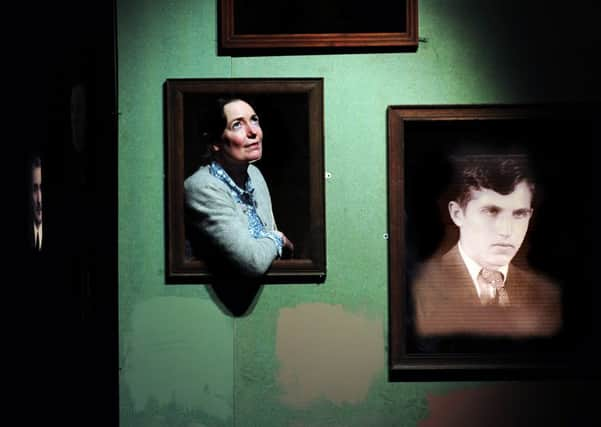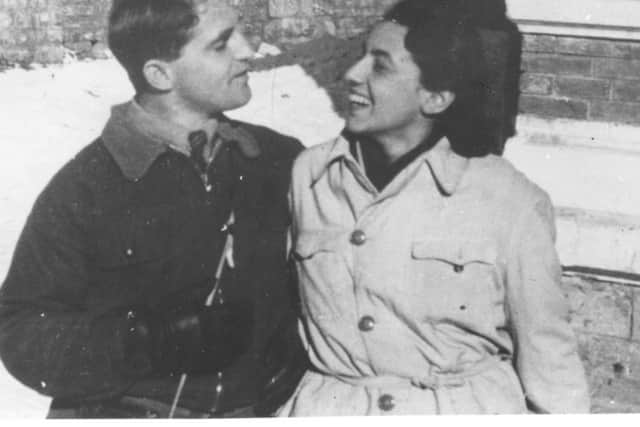Surviving the Holocaust - one family's story


The story of textile magnate Joseph Kagan has been well documented. He and his wife, Margaret, arrived in Britain in 1946 and settled in Huddersfield, having fled the Nazi occupation of their native Lithuania.
Lord Kagan, as he later became, created a multi-million pound empire based in Elland that made raincoats from the waterproof Gannex fabric he had invented, and which were famously worn by the Queen and the Duke of Edinburgh.
Advertisement
Hide AdAdvertisement
Hide AdHe became a close friend of former Prime Minister Harold Wilson, who raised him to the peerage in his controversial resignation honours list.


However, the charismatic Lord Kagan suffered a public fall from grace in 1979 after being accused of tax evasion and was jailed for 10 months. He then went on to campaign for prison reform before his death in 1995.
But while this chapter of his life attracted much attention, the Kagans’ story of survival amidst the horrors of the Kaunas Ghetto during the Second World War is less well known.
It’s something their daughter, the artist and theatrical lighting designer Jenny Kagan, is hoping to rectify through a new exhibition which opens at Dean Clough, in Halifax, next month.
Advertisement
Hide AdAdvertisement
Hide AdOut of Darkness charts her parents’ struggle for survival and their subsequent escape from Lithuania. The Baltic state suffered dreadfully at the hands of the Nazis and the couple were among only 500 of the 30,000 Jews in Kaunas to survive the war.


The exhibition, which has been funded by Arts Council England, revolves around a series of interactive artworks that focus on her parents’ recollections of how they lived through the Holocaust.
For Jenny, who has worked on major shows like Miss Saigon and Les Misérables, it’s both a deeply personal story and one that has taken her away from her usual sphere of work.
“I wanted to tell this extraordinary tale and through it to raise questions about the way in which we deal with conflict and trauma, and the human instinct for survival,” she says, speaking from Dean Clough where she is getting the exhibition ready.
Advertisement
Hide AdAdvertisement
Hide AdAs visitors walk through the exhibition they will be encouraged to collect, and put together, the chapters of a book that each tell a short story of the Kagans’ survival, brought to life by the artwork they have seen.
For Jenny it has been a compelling labour of love that started when her mother Lady Kagan, who died in 2013, was still alive. “I’ve been working on this for five years and it’s been a creative joy to be able to put this together,” she says. “I wanted to find a different way of telling the story where the audience experiences the decisions my parents and others in similar situations had to make, rather than just hearing about them.”
Jenny says her parents didn’t try to shield her from what they had been through during the war. “I grew up with bedtime stories about their time in hiding in what they referred to as ‘the Box’.
“I was fortunate that my parents talked about their experiences because many survivors didn’t. But they didn’t do it in a frightening way, they just wanted their family to understand what they had been through.”
Advertisement
Hide AdAdvertisement
Hide AdThe “Box” in question was a tiny six foot hiding space in a factory attic that Joseph had built and which the couple shared with his mother.
Jenny has recreated two different versions of “the Box” for the exhibition, one based on her mother’s recollections and another on her father’s drawings and notes. “The difference is important because this is a show about memory and experience rather than about hard historical fact,” she says.
The wartime story of Joseph Kagan and Margaret Stromas is one of fortitude, love and survival. Joseph arrived in England in 1933 to study textiles at Leeds University but returned to Lithuania after Stalin invaded the country in 1940, only to find himself trapped there for the remainder of the war.
In 1941, following the German invasion, he was among the Jews rounded up and herded into the ghetto in the city of Kaunas. In 1943, he was introduced to Margaret, who was just 17 and nine years his junior.
Advertisement
Hide AdAdvertisement
Hide Ad“They met through one of my mum’s cousins who knew my father. He was a bit of a character, he could get sausages and he had a record player and after he met my mother he decided he was going to marry her, which he did.”
They survived for nine long months but with the Nazis in full retreat and the war coming to an end, the couple made their way through Europe to Bucharest where they briefly got jobs with the British consul before finally arriving in Britain.
Jenny says her parents’ experience of the war affected them deeply for the rest of their lives. “They taught me that horrific situations bring out the worst in many people but also the very best in others.
“My mother said to me once that she was worried that I had it too easy because what she had been through when she was younger shaped who she was.”
Advertisement
Hide AdAdvertisement
Hide AdMargaret’s father, George, was beaten to death just days after the German invasion and her mother, Eugenia, was deported to the Stutthof concentration camp in Poland in 1944, where she took her own life four months later.
“My mother came out of the war with a surprising amount of optimism and hope even though she had lost both her parents and a lot of her extended family.
“She saw the worst of humanity but, thanks to the people who helped save her, she also saw the best of humanity and that’s one of the things I wanted to focus on in this exhibition.”
The experience left a lasting mark on her father, too. “His tenacity and ability to solve problems was honed during those days in Lithuania,” she says.
Advertisement
Hide AdAdvertisement
Hide Ad“My father was a larger than life character who courted controversy throughout his life. His later trials and tribulations are well documented, but this show tells the story of my parents as young people, who survived against all the odds, because of both luck and their ingenuity.”
Jenny believes it’s a story that still resonates in the world today given the upheaval witnessed across parts of Europe with the arrival of hundreds of thousands of migrants.
“It’s about how we deal with conflict and trauma and what it’s like to experience persecution and fear and having your lives torn apart,” she says.
“It’s a story that is still within living memory and it’s important that we remember and we don’t forget.”
Advertisement
Hide AdAdvertisement
Hide AdOut of Darkness opens at The Viaduct, Dean Clough, Halifax, on May 7 and runs until July 10. The exhibition, suitable for anyone aged eight and over, will be open to schools, colleges and groups from Mondays to Wednesdays, and to the general public from Thursdays to Sundays, 10am-5pm. For more details go to www.out-of-darkness.co.uk
Love blossomed in the ghetto
JosePh Kagan, a former Leeds University student, met Margaret Stromas in the Kaunas ghetto in 1943 during the Nazi occupation of Lithuania and the pair married later that year.
With the help of a Lithuanian non-Jew, Vytautas Rinkevicius, who risked his life to save them, they lived in a small box in a factory attic, along with Joseph’s mother Mira, just outside the ghetto walls for nine months.
Near the end of the war they escaped to Romania and from there to England where Kagan’s entrepreneurial brilliance soon saw him making his mark on the West Yorkshire textile landscape.
The couple had three children – Michael, Daniel and Jenny, who lives in Cumbria.